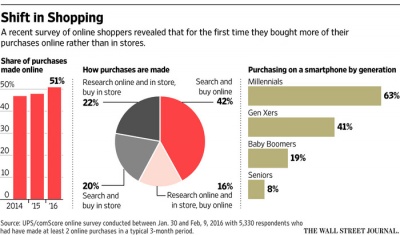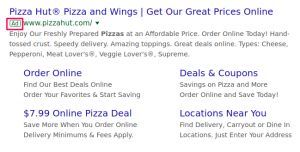Digital Marketing

Digital marketing is defined as the application of digital media, data, and technology, along with traditional communication techniques for marketing.[2] In 2020, U.S. consumers spent $861.12 billion dollars buying items online, causing the U.S. eCommerce to grow forty-four percent. [3] The Covid-19 pandemic has altered online shopping habits and shifted society towards more digital dependence. Companies such as Amazon, Target, and Walmart have picked up on these trends and are transforming their online retail and improving their digital marketing. Currently, more companies are starting to realize that if they are “not findable on the web”, they will not be able to reach the modern consumer.[4]
Online shopping has been on the rise since the early 2000s.[5] Consumers also appreciate the privacy and discreteness of eCommerce shopping. Digital marketing tactics play on these shifting habits and have become much more than simple Facebook ads and disposable corporation emails. Today, there are many types of digital marketing including Search Engine Optimization (SEO), Pay-per-Click (PPC), Social Media Marketing, Content Marketing, Email Marketing, Mobile Marketing, and Market Analytics [4] [6]. Even though these are different mechanisms of marketing, all of these platforms want traffic to their website to pay the bills of the digital marketers. The shift to online shopping has led companies to exploit consumers by selling their personal information in exchange for them falling for their digital marketing techniques and shopping comfortably from their homes.
Contents
Types of Digital Marketing
Search Engine Optimization
Search engine optimization (SEO) makes use of the search engine for marketing purposes. Search engine optimization is the process of enhancing website content so that the website can appear at the top of results in particular searches. There are many techniques in doing so, which can be categorized as either white hat SEO or black hat SEO.[7] White hat SEO refers to any method that improves search rankings on a search engine while upholding the search engine's terms of service. Examples of white hat SEO include using descriptive metatags and making the website more user and application friendly. In contrast, black hat SEO is a disapproved practice which increases search rankings through means that violate the search engine's terms of service. Examples of black hat SEO include adding irrelevant keywords in hopes of increasing website traffic and copying content from another website, with or without their permission.
Pay-Per-Click
Pay-per-click (PPC) is a method of attracting visitors to a website through advertisements.[8] In this process, advertisers only pay for the results, which is when a person clicks on their ad. An example of PPC is Google Ads, which is a popular PPC advertising systems in the world. Every time a person searches something on Google, the search engine chooses several advertisements from a pool of advertisements based on certain criteria and then displays it.[9]
Social Media Marketing
Social media marketing takes advantage of social media to promote a product or service. There are two ways in doing so, the passive approach and the active approach.[10] The passive approach consists of analyzing information on social media sites such as people's opinions and reviews to guide a course of action. On the other hand, the active approach involves directly interacting with people. This can be accomplished through creating and sharing content or having a conversation with another person. An example of this includes posting text, images, or video updates. Social media marketing ultimately allows companies to engage with existing customers and reach new ones.
Ethical Implications
Identities on Social Media
One of the ethical implications of digital marketing is the misrepresentation of identities on social media. Social media influencers and other online employees have marketed a company’s products or services on social media without disclosing their involvement with them.[4] This is considered false advertising because an influencer’s endorsement message should have an apparent and understandable relationship with the brand and its product. For example, when the Kardashians were marketing SugarBearHair products on Instagram, they violated several Federal Trade Commission (FTC) guidelines by not disclosing that they were being paid to endorse the product. [11] According to the Federal Trade Commission, if a sponsor is not acknowledging the true intentions behind a certain product advertisement, then they are misleading the consumer. The misjudgment of the product would not allow the consumer to make the best incentive for the decision to buy. Therefore, the company and who they pay to digitally market their items (or services) is responsible for false advertising practices and needs to be held accountable.
Consent
The other ethical implication is the consent of the user, whether it be through email or some other medium, to be contacted. In fact, the Federal Trade Commission has also set guidelines with regards to contacting the consumers. These guidelines include but are not limited to unsubscribing when requested, identifying the emails as an advertisement, not using deceptive subject lines, and letting the consumers know how to unsubscribe from the emails[12] or whatever other medium is used for advertising. These guidelines are intended for the consumers to be protected from the digital marketers, but these can help the marketers in terms of building trust between the consumer and the marketer.
Privacy
Digital marketing also faces criticism over consumer privacy, in regard to the practice of gathering and storing data. These issues range from consumer data collection, unauthorized access of consumer data, unauthorized secondary use of consumer data, and consumer data accuracy[13]. The Big Data movement has allowed companies to collect vast amounts of personal information about customers, such as their search history or posts on social media. Other information that may be collected and held by companies includes details about a user visiting a website, applying for a credit card, online purchases, and more.[14].This collected data is then mined or sold to third-party companies to perform statistical analysis, enabling companies to improve on their performance of market research and consumer segmentation, and identifying key information about company issues.[15] It can be argued that both marketers and customers can benefit from the storing of data in databases since customers may be able to receive special offers on items that match their preferences.[14] However, some consumers feel that this collection of data is a violation of their privacy and puts consumers at risk in the event of a company database or website database breach, which may compromise their sensitive information.[14]
Scams
Since online transactions typically require the customer to enter their credit card information, customers worry that poor security of the company’s database may lead to consequences such as internet fraud, identity theft, and financial scams, etc[16]. Additionally, the growth of digital marketing and online shopping has led to an increasing number of internet scams, that typically result in financial loss.[14] In 2017, the total monetary loss from internet scams was estimated to be more than $800 million.[14] Phishing is one fraudulent internet practice that uses deceptive emails and fraudulent online websites to trick users into disclosing their personal data, such as usernames and passwords, banking information, Social Security numbers, and more.[14] Not only does this result in potential identity theft and financial loss, but the professional image of reputable online marketers may be ruined or wrongly judged, since such scams may lead to a loss of trust from individuals in website, email, and other digital or online transactions.[14]
References
- ↑ Stevens, Laura. “Survey Shows Rapid Growth in Online Shopping.” The Wall Street Journal, Dow Jones & Company, 8 June 2016, www.wsj.com/articles/survey-shows-rapid-growth-in-online-shopping-1465358582.
- ↑ Chaffey, Dave, and Fiona Ellis-Chadwick. Digital Marketing. 7th ed., Pearson, 2020, Google Books. Retrieved from books.google.com/books?hl=en&lr=&id=-1yGDwAAQBAJ&oi=fnd&pg=PT20&dq=digital marketing concerns&ots=XiQq4PiO60&sig=nH1YOJtaxjiNbT-g-1srVPz4xOU#v=onepage&q=digital marketing concerns&f=false.
- ↑ Fareeha Ali | Jan 29, 2., Fareeha Ali | Jan 29, 2., Don Davis | Feb 2, 2., Fareeha Ali | Oct 15, 2., & Fareeha Ali | May 28, 2. (2021, March 01). US eCommerce grew 44.0% in 2020. Retrieved March 18, 2021, from https://www.digitalcommerce360.com/article/us-ecommerce-sales/#:~:text=Consumers%20spent%20%24861.12%20billion%20online,the%2015.1%25%20jump%20in%202019
- ↑ 4.0 4.1 4.2 Kirwan, Dennis. “Council Post: Digital Marketing Matters Now More Than Ever.” Forbes, Forbes Magazine, 24 Apr. 2020, www.forbes.com/sites/forbesagencycouncil/2020/04/24/digital-marketing-matters-now-more-than-ever/?sh=6eb52b4e1b1c.
- ↑ Scott, A. (2001, February). Online Shopping on the Rise. Internal Auditor, 58(1), 15. https://link.gale.com/apps/doc/A71268469/AONE?u=umuser&sid=AONE&xid=c62c14de
- ↑ Bogle, S. (2020, February 12). What are the 7 Types of Digital Marketing? Retrieved March 19, 2021, from https://www.snhu.edu/about-us/newsroom/2017/11/types-of-digital-marketing
- ↑ Pollitt, H. (2020, May 04). White Hat vs. Black Hat vs. Gray Hat SEO: What’s the Difference? Retrieved April 09, 2021, from https://www.searchenginejournal.com/white-hat-vs-black-hat-vs-gray-hat-seo/365142/
- ↑ What is PPC? Pay-Per-Click Explained. (2020, May 05). Retrieved April 09, 2021, from https://www.portent.com/services/ppc/pay-per-click-explained
- ↑ Perricone, C. (2021, January 19). The Ultimate Guide to Google Ads [Examples]. Retrieved April 09, 2021, from https://blog.hubspot.com/marketing/google-adwords-ppc
- ↑ Odden, L. (2007, October 16). Is Your Social Media Marketing Strategy Passive or Active? Retrieved April 09, 2021, from https://www.toprankblog.com/2007/10/is-your-social-media-marketing-strategy-passive-or-active/
- ↑ Maheshwari, S. (2016, August 30). Endorsed on Instagram by a Kardashian, but is it love or just an ad? Retrieved March 18, 2021, from https://www.nytimes.com/2016/08/30/business/media/instagram-ads-marketing-kardashian.html
- ↑ “CAN-SPAM Act: A Compliance Guide for Business.” Federal Trade Commission, 15 Jan. 2021, www.ftc.gov/tips-advice/business-center/guidance/can-spam-act-compliance-guide-business.
- ↑ Zhang, R., Chen, J., & Lee, C. (2013) Mobile Commerce and Consumer Privacy Concerns, Journal of Computer Information Systems, 53:4, 31-38, DOI: 10.1080/08874417.2013.11645648
- ↑ 14.0 14.1 14.2 14.3 14.4 14.5 14.6 Mandal, P. C. (2019). Public Policy Issues in Direct and Digital Marketing – Concerns and Initiatives. International Journal of Public Administration in the Digital Age, 6(4), 54-71. doi:10.4018/ijpada.2019100105
- ↑ Saura, J. R. (2021). Using Data Sciences in Digital Marketing: Framework, methods, and performance metrics. Journal of Innovation & Knowledge, 6(2), 92-102. doi:10.1016/j.jik.2020.08.001
- ↑ Ashworth, L., & Free, C. (2006). Marketing Dataveillance and Digital Privacy: Using Theories of Justice to Understand Consumers’ Online Privacy Concerns. Journal of Business Ethics, 67(2), 107-123. doi:10.1007/s10551-006-9007-7
